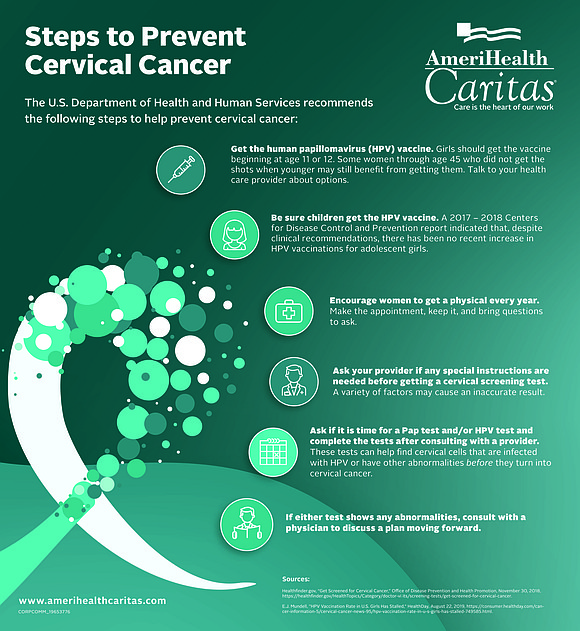Socioeconomic Factors Increasing Cervical Cancer Rates for Some in the U.S. Despite Downward Nationwide Trends
AmeriHealth Caritas Shares Advice to Help Women Prevent Cervical Cancer
Style Magazine Newswire | 1/24/2020, 1:35 p.m.
Cervical cancer is a preventable disease, yet a large number of Americans are still dying from it--especially black and Hispanic women. While deaths are decreasing as more women have been vaccinated against HPV, the leading cause of cervical cancer, there are still an estimated 11,900 new cases of cervical cancer being diagnosed in the U.S. each year. To prevent these results, it is crucial that women keep themselves informed as recent cervical cancer testing recommendations and HPV vaccination age limit have changed.
According to the Centers for Disease Control and Prevention (CDC), from 2011-2015, seven white women per 100,000 had cervical cancer, while 8.4 black women and 9.1 Hispanic women were diagnosed with it. Social determinants of health, or socioeconomic factors that influence one’s health such as income, food security, housing security, education, and employment, play a part, said Rodney Wise, M.D., F.A.C.O.G., a market chief medical officer at AmeriHealth Caritas. “If a woman is worried about paying her rent and how she is going to feed her family, it is less likely she is going to take preventive steps to ensure optimal health,” said Dr. Wise.
Screening recommendations changed in 2018 from yearly Pap tests for women to a more staggered schedule recommended by The American College of Obstetricians and Gynecologists. In June 2019, the CDC’s advisory committee on immunization practices said some might benefit from getting the HPV vaccine up to age 45. The vaccine is recommended for preteens to protect them before exposure to the virus, but historically catch-up vaccinations had been capped at age 26.
Keeping up with the changes in testing guidelines and knowing the new HPV vaccine recommendations can help make a difference in eliminating health disparities. For example, Spanish speaking patients may need additional assistance if signs and collateral materials at their provider’s offices are not bi-lingual.
The U.S. Department of Health and Human Services recommends the following steps to help prevent cervical cancer:
1. Get the HPV vaccine. Girls should get the vaccine beginning at age 11 or 12. Some women up to 45 who did not get the shots at a younger age may still benefit from getting them now. Talk to your health care provider about options and with your health plan to be certain the vaccine will be covered.
2. Be sure children get the HPV vaccine. A new CDC report that looked at 2017-2018 data indicates there has been no recent increase in HPV vaccination rates for adolescent girls despite clinical recommendations to get them. “Calling it the cancer prevention vaccine removes some of the stigma surrounding giving children shots to prevent an STD,” said Dr. Wise.
3. Encourage women to get a physical visit every year. Make an appointment with your doctor, keep it, and bring questions to ask.
- Ask the provider if any special instructions are needed before getting a cervical screening test. A variety of factors may cause an inaccurate result.
5. Ask if it is time for a Pap test and/or HPV test and have the tests done after consulting with a provider. These tests can help find cervical cells that are infected with HPV or have other abnormalities before they turn into cervical cancer.
6. If either test shows any abnormalities, consult with a physician to discuss a plan moving forward.
Sources
Centers for Disease Control and Prevention - cdc.gov
American Cancer Society – cancer.org
Washington Post – washingtonpost.com




